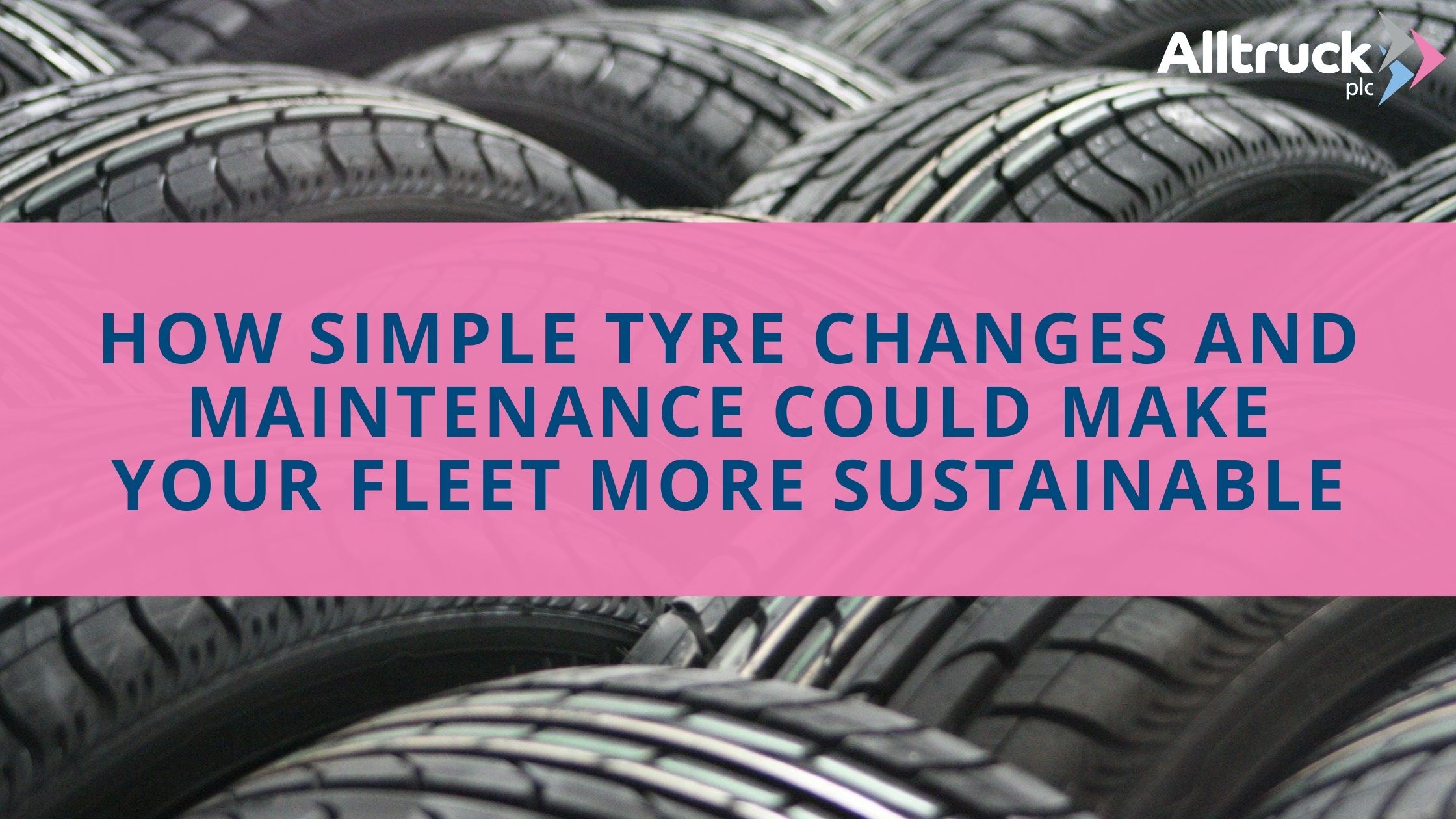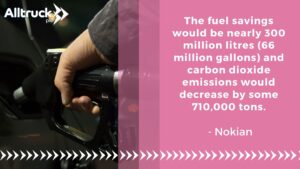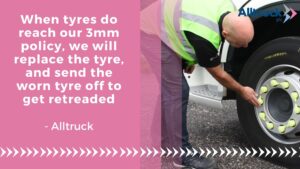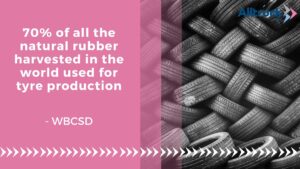
Truck operators have more ways to make environmentally friendly choices today than they may realise. Your lorry tyres have a direct impact on air pollution. In fact, they can be responsible for up to 20% of CO2 emissions in urban areas. However, Alltruck Zero has been doing research into how you can decrease these emissions and make your fleet greener.
Trucks are becoming more environmentally friendly, there’s no doubt about it. Operators’ focus is being increasingly shifted to sustainability. This is both driven by legislation and the growing wish the population has to protect our environment, whilst still keeping the flow of goods moving. But it’s not just the truck manufacturers who are moving to more sustainable models, but parts, oils, lubricants, fuel, trailers, and tyres are all concentrating on sustainability.
Some readers may not know that tyres can have a negative impact on the environment. This stems from how the materials for the tyres are sourced, the production of the tyres, the energy lost when the tyre is moving as you drive, the tiny particles that are released in motion, and how long your tyres last. Plus, since tyres are disposable, the growing demand for new tyres comes with a continuous build-up of used tyres
In fact, according to tyre experts, Goodyear, in urban areas truck tyres can be responsible for up to 20% of CO2 emissions. For fleets on long-haul motorway trips, it can be 35%. [1]

But it’s not all bad news, there are things you can do to lower these emissions.
One way you can lessen your emissions is by choosing tyres with lower rolling resistance. Rolling resistance refers to the energy lost when the tyre is moving as you drive. Low-rolling-resistance (LRR) tyres are often overlooked as a means of improving sustainability.
However, the lower the rolling resistance, the less energy lost, and thus the less fuel needed. By improving fuel efficiency, the truck’s overall carbon footprint will be reduced. For electric vehicles, lower rolling resistance will also mean a longer driving range.
There are several different factors that can impact rolling resistance. As such, the production of this type of tyre is a complex process. Mindful tyre manufacturers will assess the design of the tread profile for ways of optimising the deformation caused by load and motion forces, as well as opportunities to use the most advanced raw materials.
Gary Powell, the Technical Manager at Bridgestone, addresses the concerns that operators have over LRR tyres being less durable than standard tyres. Powell assures us that the whole point of these tyres is to make fuel savings and therefore offset the lower tread costs. [2]
LRR tyres might not sound like a ground-breaking revelation, but the results are startling. Goodyear found that a fleet of 100 trucks using an LRR range can lower its total cost of ownership (TCO) by more than £35,000 per year on fuel costs; a saving which suggests an equally significant environmental impact. Nokian also found similar results. They offered the example that if all passenger cars in Finland, Sweden and Norway used low rolling resistance winter tires, the fuel savings would be nearly 300 million litres (66 million gallons) and carbon dioxide emissions would decrease by some 710,000 tons. [3] These are statistics that aren’t to be ignored.

When we talk about sustainability and tyres, it’s impossible to understate the importance of proper maintenance. Keeping tyres at the correct pressure not only reduces the chance of suffering a tyre-related breakdown, but also further enhances rolling resistance, meaning the vehicle is likely to consume less fuel.
At Alltruck, we do all we can to take great care of the tyres on the trucks and vans that come into our workshop. When a vehicle comes in for an inspection, our specially trained tyre technicians thoroughly check the tyres for any cuts, tears, bulges, or objects, and ensure that they are maintaining the correct pressure, as well as have enough tread.
Although 1mm of tread is the legal minimum for tyres, we believe that for both safety and economic reasons, tyre tread shouldn’t fall below 3mm. When tyres do reach our 3mm policy, we will replace the tyre, and send the worn tyre off to get retreaded by retread specialists, Bandag. We are sometimes even able to get ahead of the game and recut (or regroove) tyres if they are above 5mm, which can prolong their life further. Our tyre partner, Bridgestone, has recently bought out an app to help with this process. [4]

When properly maintained, a typical truck tyre can last for around 100,000km.
As aforementioned, it is good practice to get your tyres recut or retreaded wherever possible.
Powell emphasises that to be sustainable and help ensure a healthy environment for current and future generations, tyre companies must value our natural resources. The best way to do this is by reusing, recycling, and getting the maximum usage out of your tyres. We should all aim to balance business success and the use of earth’s resources.
By choosing to retread your worn tyres and giving them a second or even third life, your fleet can save up to 70% litres of oil, 32 kg of rubber and 14 kg of steel compared to a new tyre (per tyre, for size 315/80R22.5). [5] Opting for recycled materials also means that you are contributing to a circular economy and supporting the development of future sustainable tyres.

Tyre innovation is rapidly accelerating, with new solutions and materials, such as soybean, dandelion, or even rice husk ashes. It is important to do your research and choose companies that are investing in finding more sustainable sources for the materials they use.
Rubber is a crucial component of the tyre, with most tyres typically containing a complex blend of both natural and synthetic rubber, as well as other materials such as steel and plastics.
Unarguably, the tyre industry is the biggest consumer of natural rubber, with 70% of all the natural rubber harvested in the world used for tyre production. [6] There’s no denying that our growing demand for goods to be transported is having a roll-on effect (no pun intended!) on tyre production. Our demand for rubber is only set to increase.

Currently, nearly all the natural rubber produced in the world is harvested from the milky sap (latex) of the “Rubber Tree” (Hevea Brasiliensis). This is problematic as the rubber tree is a notoriously picky species that requires specific climatic conditions for growth, to the extent that its cultivation is restricted to tropical regions close to the equator. This is exemplified by the fact that 90% of rubber tree plantations are located in South East Asia. [7] Plus, the rubber tree takes 7 years before it starts producing the latex that we use in tyres.
However, tyre companies are finding alternatives in so-called ‘bio-rubber’:
There are also steps being made with the synthetic rubber that tyre companies are using:
An enormous amount of development goes into creating a tyre that ticks all of the boxes on the operational side and this, coupled with a growing awareness of the finite amount of conventional raw materials, means that tyre manufactures are having to invest in new research and technology that can provide us with the best of both worlds.
It is certainly exciting and encouraging to see the pledges that these leading tyre companies have made. However, a lot of the responsibility still rests on our shoulders as tyre consumers. We must make sure that we are maintaining our tyres correctly, getting them recut and retreaded where possible, and opting for LRR tyres when suitable.
It is rather incredible what difference a tyre can make.
We will be regularly posting tips and tricks on how you can make your fleet more eco-friendly, as well as updates on our own “Road to Zero” journey. So, if you would like to join the movement towards a sustainable transport industry, please sign up for our Alltruck Zero mailing list to stay in the loop by emailing Hannah.Sowerby-Hill@alltruckplc.co.uk.
[1] Boucharlat, Gregory and Glesener, Ben, ‘Three Ways Your Tyres Could Make Your Fleet More Sustainable’, Commercial Vehicle Engineer (December 2020) <https://www.thetruckexpert.co.uk/cve/2012/2012-12.html#p=6> [Accessed 24 February 2021]
[2] Powell, Gary, ‘Future Technology: An environmentally friendly future that delivers dividends for all’, The Commercial Motor Show Online (29 September 2020) <https://thecommercialmotorshow.vfairs.com/> [Accessed 25 February 2021]
[3] Anon, ‘Your tires can help reduce the CO2 emissions – Nokian Tyres works towards greener tires’, Nokian Tyres (5 June 2019) <https://www.nokiantyres.com/company/news-article/your-tires-can-help-reduce-the-co2-emissions-nokian-tyres-works-towards-greener-tires/> [Accessed 25 February 2021]
[4] Anon and Turner, Paul, ‘Bridgestone outlines regrooving app’ in Commercial Vehicle Workshop Magazine Online (1 October 2020) <https://cvwmagazine.co.uk/features/bridgestone-outlines-regrooving-app/> [Accessed 26 February 2021]
[5] Anon, ‘Retreading: a life-lengthening process’, International Bipaver (N/A) <https://bipaver.org/retreading/> [Accessed 2 March 2021]
[6] Anon, ‘The Global Platform for Sustainable Natural Rubber’, WBCSD (N/A) <https://www.wbcsd.org/Sector-Projects/Tire-Industry-Project/The-Global-Platform-for-Sustainable-Natural-Rubber> [Accessed 2 March 2021]
[7] Anon, ‘Transforming the global rubber market’, WWF (Winter 2016) <https://www.worldwildlife.org/projects/transforming-the-global-rubber-market> [Accessed 2 March 2021]
[8] Anon, ‘Continental Opens “Taraxagum Lab Anklam” Research Laboratory for Dandelion Rubber’, Continental (6 December 2018) <https://www.continental-tires.com/car/about-us/media-services/archive/archive-2018/20181206-continental-opens-taraxagum-lab-anklam> [Accessed 2 March 2021]
[9] Anon, ‘Bridgestone develops new technology for improving guayule-derived natural rubber productivity’, US Tire Manufacturers Association (28 January 2021) <https://www.ustires.org/bridgestone-develops-new-technology-improving-guayule-derived-natural-rubber-productivity> [Accessed 2 March 2021]
[10] Goodchild, Stephen, ‘BioButterfly: Michelin site to gain prototype bioethanol-based butadiene plant’, Tyre Press, (27 September 2019) <https://www.tyrepress.com/2019/09/biobutterfly-michelin-site-to-gain-prototype-bioethanol-based-butadiene-plant/> [Accessed 2 March 2021]
[11] Johnson, David, ‘Michelin tyres will be 100 per cent sustainable by 2050’, Michelin UK and Ireland (25 February 2021) < https://news.michelin.co.uk/michelin-tyres-will-be-100-per-cent-sustainable-by-2050/> [Accessed 2 March 2021]
[12] Anon, ‘Development of Sustainable Materials’, Goodyear Corporate (N/A) <https://corporate.goodyear.com/en-US/responsibility/sustainable-sourcing/sustainable-materials.html> [Accessed 2 March]